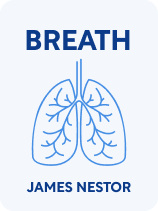

This article is an excerpt from the Shortform book guide to "Breath" by James Nestor. Shortform has the world's best summaries and analyses of books you should be reading.
Like this article? Sign up for a free trial here.
Do you breathe correctly? What’s the best way to breathe from a health perspective?
Most of us don’t know how to breathe properly. As a result, we unnecessarily tax our respiratory systems and suffer from avoidable breathing problems, such as chronic congestion, fatigue, and infections.
Here are some tips on how to breathe better.
1. Breathe Through Your Nose
In his book Breath, James Nestor explains how to breathe better. First of all, you need to retrain yourself to use your nose and not your mouth to breathe. Your nose and sinus cavity are specifically designed to process air in ways your mouth can’t. Breathing through your nose strengthens your airways, regulates your metabolism, and even has a positive effect on the brain.
The immediate effect of breathing through your nose is that the tissues in your sinus and the back of your throat cease to atrophy from lack of use. As with muscles, the sinus and throat will grow stronger with exercise; they will soon function better and allow for a healthier airflow. Meanwhile, the nose’s cilia (fine hairs) and turbinates (boney structures) heat and clean the air you inhale so your lungs can extract more oxygen from it. The sinus also releases nitric oxide into the body, which widens blood vessels and increases circulation. In the author’s self-experiment, when he unplugged his nostrils, in only a few days his blood pressure went down and his blood’s carbon dioxide returned to normal.
But it’s not just the act of breathing that does this. Nestor writes that there is a nasal cycle in which the right and left nostril alternate to control body temperature, blood pressure, and brain chemicals. (If you notice from time to time that one nostril congests while the other stays open, and then they mysteriously switch later on, this is the nasal cycle in action.) When breathing through your right nostril, your pulse, blood pressure, body temperature, and cortisol levels increase. Breathing through the left nostril has the opposite effect, and cycling between the two maintains your body’s balance. Breathing through your mouth, on the other hand, disengages the nasal cycle completely, depriving you of its body-regulating benefits.
Furthermore, the nasal cycle helps regulate the brain. The right nostril is connected to the sympathetic nervous system, raising alertness and logical thinking. Likewise, the left nostril is linked to the parasympathetic nervous system, affecting creativity and abstract thought. By switching the breath back and forth between the two, the body maintains mental equilibrium between states of relaxation and alertness.
2. Slow Your Breath Down
While switching to breathing with our noses may seem simple, the next step will take more concentration and practice. According to Nestor, our optimal breath rate is slow—much slower, in fact, than what we’re used to. To explain why this is, we must understand the vital role that carbon dioxide plays in our body chemistry and how breathing slowly will affect our chemical balance. Beyond that, Nestor asks us to consider the benefits of not only breathing slowly, but breathing less air all at once.
The science we’re taught in school is basically true—we inhale oxygen and exhale carbon dioxide. What’s false, says Nestor, is the implication that carbon dioxide is merely a waste product, when in fact it’s a vital part of the chemical exchange that gives the oxygen in our blood access to our organs. As our muscles and organs do more work, they burn energy and create carbon dioxide, which releases oxygen from the hemoglobin in our blood cells. As stated earlier, heavy breathing purges carbon dioxide from the body, which short-circuits the necessary chemical exchange and starves our cells of the very oxygen they need.
Nestor writes that breathing more slowly doesn’t lower the amount of oxygen in the body, but it does increase the amount of carbon dioxide, allowing more of the oxygen to be absorbed. When we breathe “normally,” we only absorb about 25% of the oxygen we take in. On the other hand, slow breathing lets us absorb more oxygen using fewer breaths—a more efficient process for the whole body that uses less work to produce more energy. Oxygen flow to the brain increases, and all our other bodily functions align themselves to work at top efficiency.
The idea of breathing more slowly isn’t new. Spiritual practices from all around the world have ritualized slow breathing in the form of meditations, chants, and prayers. Nestor points out that all these disparate traditions, whether Tibetan or Catholic or Native American, have settled on approximately the same ideal breath rate: 5.5 seconds to breathe in, 5.5 seconds to breathe out. This, it seems, is the ideal rate of breath to bring the body and mind into alignment.
Hypoventilation
Some researchers believe that breathing less air can increase the body’s overall performance. Known as “hypoventilation training,” this involves limiting your inhalations during exercise while extending the time you take to exhale. This accustoms the body to higher carbon dioxide levels and trains you to take in less air while resting. Studies have shown that this practice heightens athletic performance and is beneficial to people who suffer from asthma. Patients undergoing hypoventilation therapy developed higher resting carbon dioxide levels and fewer asthma attacks. Nestor admits that hypoventilation isn’t for everyone, in particular people who have emphysema (and therefore, already high levels of carbon dioxide).
He also states that no one’s really sure why hypoventilation training works. The leading theory is that it affects the body’s pH level (the body functions best at pH 7.4). Our “normal” practice of overbreathing makes the blood more alkaline, and other organs such as the kidneys have to release chemicals into the blood to compensate, which over time depletes the body’s minerals. Breathing less air, then, resets our pH without putting extra stress on the body’s resources.
3. Strengthen Your Diaphragm and Mouth
Now that we’ve examined the benefits of breathing through your nose and slowing your breath, we’ll discuss how to strengthen your body’s breathing apparatus. Nestor focuses on two particular areas: the diaphragm muscle that drives your breathing and the muscles and bones of the face that support your vital airways. Training the diaphragm to work harder has been shown to help both patients with breathing problems and Olympic athletes, while strengthening the muscles of the face can help anyone undo the damage of a life of soft foods.
Strengthening the diaphragm has long been the province of vocal coaches, in particular choir director Carl Stough, whose success training singers to improve their lung capacity led him to join forces with doctors treating people with tuberculosis. By training the patients to better use their diaphragms, they were able to regain more use of their lungs and improve their quality of life. Driven by the diaphragm, the pressure of our lungs breathing in and out creates a process called the thoracic pump, which brings blood back to the heart to replenish it with oxygen. Stough went on to bring his diaphragm-strengthening techniques to athletic training, enabling several Olympians to break their personal records in the 1968 games.
In order to maximize the benefit of diaphragm training, it’s vital to open your airways. Nestor says that to do this, you should learn to maintain good oral posture, holding your mouth closed with your teeth gently touching and your tongue against the roof of your mouth. This positions your face to maximize the airways that allow you to breathe through your nose.
Oral posture is hard to maintain if your face is out of shape from a lifetime of soft foods, but it can be toned and strengthened like any other part of your body. Nestor explains that the maxilla (the primary facial bone) is more malleable than any other in the body—it can grow and reshape itself all our lives. It does this via stem cells in the seams between the bones in your skull, cells that are activated by the act of chewing. Therefore, eating hard, unprocessed foods promotes increased bone mass in your face and strengthens the muscles that hold your airways open. You can also increase bone mass by using an oral appliance designed to widen the mouth.

———End of Preview———
Like what you just read? Read the rest of the world's best book summary and analysis of James Nestor's "Breath" at Shortform.
Here's what you'll find in our full Breath summary:
- Why you're probably breathing wrong
- The benefits of learning how to breathe properly
- The potentially dangerous side effects of mouthbreathing






